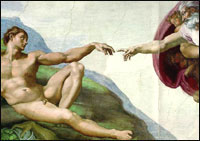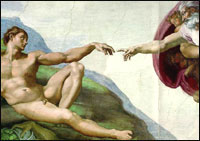As an environmentalist who used to work for nuns, I’m fascinated by other enviros’ views of religion. Many fear or shun religious practice, and yet religious imagery and themes are prevalent throughout environmental thought, as is evident in a handful of book titles from recent years: The Ecology of Eden, Tinkering with Eden, God’s Last Offer, And the Waters Turned to Blood.
In Reinventing Eden: The Fate of Nature in Western Culture, Carolyn Merchant, an environmental historian at the University of California at Berkeley, analyzes how one religious theme — the Christian interpretation of the Genesis story — has shaped worldviews through history, both mainstream Western views and environmental thinking. The book makes fascinating reading, and her insights might help environmentalists frame more effective messages for the public at large.
The Christian take on Genesis as the story of a fall from grace is familiar to most of us. In “Extracts from Adam’s Diary,” Mark Twain sums it up:
“[Eve] has taken up with a snake now. The other animals are glad, for she was always experimenting with them and bothering them, and I am glad, because the snake talks, and this enables me to get a rest. She says the snake advises her to try the fruit of that tree, and says the result will be a great and fine and noble education … I advised her to keep away from the tree. She said she wouldn’t. I forsee [sic] trouble. Will emigrate.”
Of course, Eve ate the fruit, trouble ensued, both emigrated, and, Merchant argues, the attempt to return to Eden has been the driving force behind Western culture ever since.
Merchant traces this theme through the works of the usual suspects from Intro to Humanities: Plato, Hesiod, Ovid, Virgil, Dante, Newton. In time, overtly religious language was superseded by that of secular science, but Merchant demonstrates that the underlying story remained largely the same when told by Bacon, Locke, and Descartes.

Before the fall.
While classical and medieval philosophers envisioned a spiritual return to Eden, Enlightenment thinkers began to imagine that Eden could be recreated physically — in the Americas. Most Europeans saw the land as capable of being turned into Eden through human (specifically male) ingenuity. Paradise could be reinvented by “a heroic Adam acting to improve a nature depicted variously as a virgin, fallen, or fruitful Eve.” Merchant provides many examples of text and paintings in which the land of the New World is depicted as a female in need of redemption through, shall we say, cultivation. Take the words of colonist Thomas Morton, who in 1632 compared New England to a “faire virgin longing to be sped and meete her lover in a Nuptiall bed. Her fruitfull wombe not being enjoyed is like a glorious tombe.”
Meanwhile, an emerging environmental counter-narrative saw the land as already Edenic, while human presence and efforts to “improve” it were causing a slow but steady fall. As Henry David Thoreau wrote, “Perhaps on that spring morning when Adam and Eve were driven out of Eden, Walden Pond was already in existence … and covered with myriads of ducks, geese, which had not heard of the fall.”
But even the environmentalist narrative envisions recovering Eden only for a privileged few white men. John Muir’s vision of Edenic national parks required the removal of native people from their lands.
Merchant demonstrates that both environmentalist and mainstream stories stemming from the fall have been detrimental to women and people of color. She writes, “With the taming of wilderness, the removal of ‘savages’ and ‘wild men’ and the repression of blacks, the American Eden had become a colonized Eden. People of privilege were inside the garden, colonized minorities outside it or on its margins.”
Some of her conclusions may be too far-reaching. I wasn’t convinced that the notion of upward progress in Western thought always equates to desire for a “return” to the garden. And the Christian story of the imminent end of the world in a fiery apocalypse has had a greater impact on environmental policy — particularly under James Watt, Reagan’s controversial interior secretary, and perhaps under the current administration as well — than any story of a return to Eden.
Still, Merchant’s analysis is compelling, particularly if enviros use it consciously to craft more effective environmental messages. The current enviro frame is: Eden existed, we screwed it up, we’re still falling, and things are getting worse. Think of the nonstop news of climate change, extinction, habitat loss, and harm to human health. It’s like being stuck in endless reruns of The Empire Strikes Back or The Two Towers. The mainstream frame, on the other hand, says that while things were bad there for a while, we’ve made a lot of progress through innovation, technology, and hard work, and we’re already experiencing the Return of the Jedi or the King — or Eden.
The mainstream story is obviously more hopeful and compelling. In a sense, this is a complicated way of saying you can catch more flies with honey than with vinegar. But it may help enviros recognize that focusing on portraying a positive vision is not just a Pollyanna copout, but a principled and savvy way to tap into the cultural power of this story.
I leave it to the communications and marketing professionals among us to figure out what this would look like in practice, but one obvious step is to focus not on the fall but on the recovery. We could paint a powerful picture of our version of a return to Eden, which would occur via foot, bicycle, and hybrid public transit, in cities and on farms as well as in wilderness areas and parks, powered by clean energy, and inclusive of women, people of color, and all communities around the globe.



